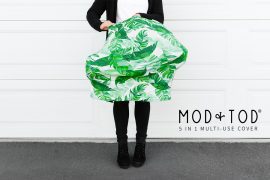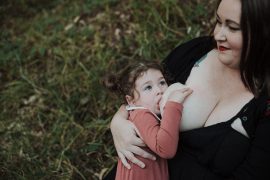So we need the big gape. But there’s no point in having a big gape if other things aren’t right too.
The baby’s chin needs to be making contact with the breast and even more than that – usually pressed into the breast a little. This means that the baby’s head will probably be slightly tilted. When you are taking a big bite out of an apple or a burger, you’ll usually lead with the chin. Usually the chin makes contact first with the breast. The nose will probably only rest very lightly on the breast or may not even touch at all. Some women with very large soft breasts find that the baby’s nose is slightly buried in too – don’t panic. Baby nostrils are very clever. They are designed to leave little air gaps around the corners even when the nose is making complete contact. You do not need to push your fingers into the breast to move the breast away so they can breathe. That’s a great way to get blocked milk ducts. Many of our ducts are quite close to the surface of the skin and pushing into the breast with a finger is enough to prevent flow. Try first encouraging your baby’s chin to tilt more into the breast. If the baby’s nose is still buried, it might just be about the consistency of your breast. The baby will prioritise breathing and come off if there’s a problem. That’s one reason we don’t hold the baby on the back of their head or put pressure on the back of their head – we need to give them the freedom to be able to come off. Holding the back of the baby’s head firmly to push them onto the breast can repress the sucking instinct and cause a baby to become quite distressed.
That’s one reason we don’t hold the baby on the back of their head or put pressure on the back of their head – we need to give them the freedom to be able to come off.
The baby’s bottom lip will ideally be a bit flanged out. A bit like a fish lip. This gives the tongue more chance of being where it needs to be – over the gum ridge and scooping breast tissue. If the lip is tucked back, the tongue is probably not far out enough. The top lip doesn’t need to be flanged out. In fact if the top lip is, that can be an indication the gape isn’t wide enough. However here’s a thing – once the baby is on the breast and feeding we can’t check lips and latch anymore. If a baby is positioned properly we probably can’t even SEE the lips and the cheeks are hiding them by making close contact with the breast. If you can see lips or see breast tissue moving in and out of lips, your baby probably doesn’t enough breast in their mouth. Be a bit wary if someone wants to check your latch by pulling at your breast or pulling baby’s cheeks. Best to check latch by watching as the baby goes onto the breast, watching how they naturally feed and looking at the shape of the nipple once it comes out of the baby’s mouth.
So we’ve got the big gape.
The more-of-a-mouthful-below-the-nipple.
The chin contact and chin driving into the breast with a head tilt.
The baby’s body should also be in a line. That’s to say ear, shoulder, hip all facing the same way. Try drinking a glass of water with your neck twisted to one side.
Baby will also be close and tight to your body if we’ve got a hope of getting that chin close enough.
What’s happening with their hands? In the early days, hands can seem a little inconvenient. However they are an important part of a baby’s sensory tools so we try and avoid swaddling when breastfeeding and soon the hands will be your friends. Ideally a baby won’t be wearing any clothing at all or be wrapped in anything when they have that first feed. You might have a sheet or blanket lightly around both of you. In the early days, if a baby can’t get their face to the breast, they’ll try and get there with their hands. We don’t want the hands to end up on the baby’s chest or tucked at their neck as this will push their upper chest away from you which pushes the chin away which means a shallower latch. Baby’s hands shouldn’t be between your bodies. We also don’t want bulky clothing between you or bras containing breast pads squashed between you. One of the reasons skin-to-skin is so great for breastfeeding is you don’t have to deal with all the unhelpful fabric in the way!
A leading cause of nipple soreness and damage is a mum holding her breast and ‘offering’ it towards the baby or ‘putting it in’. Nooooo.
What about holding your breast? Hmmm. Be careful about this. A leading cause of nipple soreness and damage is a mum holding her breast and ‘offering’ it towards the baby or ‘putting it in’. Nooooo. The breast is then going to slip subsequently and probably end up on the hard palate again. And holding breasts is a great way to end up with those blocked ducts again. Not to mention the fact that you’ll be doing this breastfeeding lark for a lot of hours and you’re going to appreciate having a hand free. Be wary of anyone who tries to ‘help you out’ by holding your breast or touching your baby. None of that should be needed. Be firm that people should help you with encouragement and words at this early stage. Touching is a last resort.
See next page for more…










